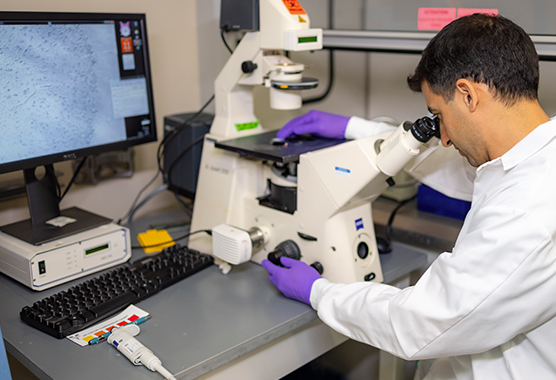Sadegh’s research addresses a fundamental gap in neuroscience: how cerebrospinal fluid (CSF) composition modulates brain function. His lab explores the potential of this new knowledge to revolutionize treatment across neurological conditions. Sadegh blends gene therapy, animal model and human tissue culture work to transform the state of science from viewing CSF as a passive medium to recognizing it as a promising precision therapeutic target.
Brain Fluids Lab

-
 Principal Investigator
Principal InvestigatorCameron Sadegh, M.D., Ph.D.
-
Research Goals
The Brain Fluids Lab studies cerebrospinal fluid (CSF) and its relationship with brain shape and function. Combining these insights with clinical experience, the team designs cellular and genetic therapies to treat hydrocephalus and other conditions causing intellectual disability.
-
Current Projects
- Gene therapy for hydrocephalus:
- People of all ages can develop hydrocephalus and related brain injury. But hydrocephalus is not inevitable. Some patients can escape it, using the brain's natural defense mechanisms of CSF homeostasis. How does that work? How can we tell which person is at risk? How can the lab augment these defense mechanisms in vulnerable patients?
- Gene therapy can target and support the critical brain epithelial cells that work to prevent hydrocephalus. We use advanced imaging tools (MRI), hydrodynamic profiling, and animal models of acquired hydrocephalus to study the optimal conditions for such a therapy to work in patients.
- Indirect neuromodulation:
- The team’s hypothesis is that CSF influences brain function, by fine-tuning the activity of neurons. This is an existing idea and is supported by prior studies of how CSF ions, hormones, growth factors, and enzymes can influence neuronal function and brain function. Strategies to bioengineer the composition of CSF could lead to a powerful approach to modulating brain activity.
- Neurosurgeons routinely access CSF, and the team collaborates to collect clinical samples to study how CSF influences neuronal activity in animal models. With the hope of restoring brain function after injury, Sadegh’s lab aims to better understand what normally nurtures brain function, what limits brain function in neurologic disorders, and how to design treatments for conditions affecting intellectual ability.
- Early brain development:
- Sadegh believes there is no better way to identify cures for neurologic disorders than by understanding how the fetal brain develops its diversity of cell types and fluid environments over time. The interaction of CSF with these early cell types is avidly debated, and his team hypothesizes that the choroid plexus plays an outsized role.
- Bearing no resemblance to its neighboring neurons and glia, the choroid plexus hides a common heritage. The same early stem cells that produce the hippocampus also generate the choroidal tissue, although with an entirely different purpose. The choroidal tissue does for the brain what the endocrine system, pancreas, liver, kidneys, and lymph nodes do for the rest of the body. There is much yet to discover.
- Gene therapy for hydrocephalus:
